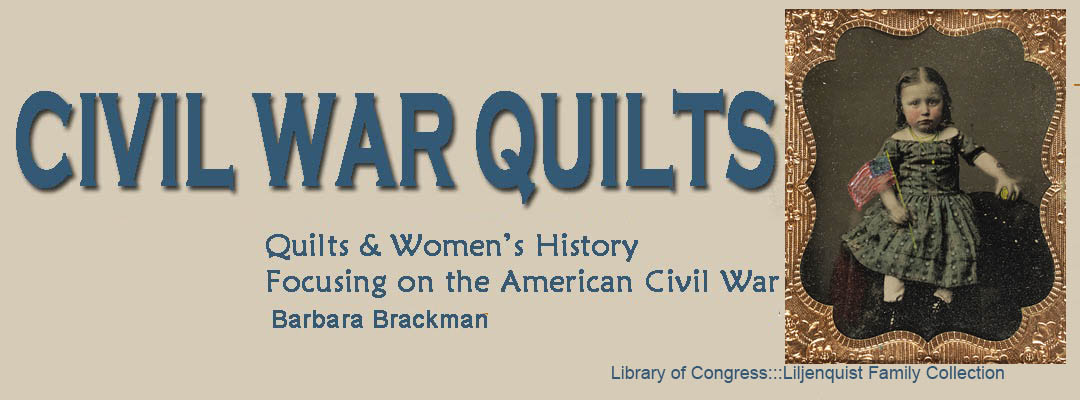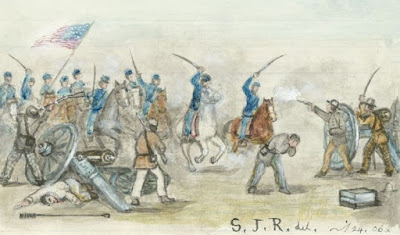Rocky Mountain Road, circa 1880–1910
Attributed to Mrs. William H. Dorey, Kentucky,
Eunice Tincher Dorey (1843–1912)
Gift of Mrs. A. J. Anderson
Curator at the Spencer Museum of Art Kate Meyer sent me a recent note. After looking through the Spencer's quilt catalog she announces she is "quietly fighting the patriarchy via biographical research---" discovering the needleworkers' names rather than using their husband's name as in Mrs....
A Lucy Stoner?
[which meant you kept your "maiden" name]
Perhaps, she asked, I could add to Eunice Tincher Dorey's story? I am always glad to fight the patriarchy and spend a little time in the past.
Kate had discovered the name of Mrs. William H Dorey, as attributed on page 184 of Carrie Hall & Rose Kretsinger's book The Romance of the Patchwork Quilt in America. Together we have discovered a lot about this quilt and the family who donated it.
When she was about 17 Eunice Tincher came to Fort Scott, Kansas just before the Civil War from Newport, Indiana with family members: mother, stepfather and sisters. In the first months of the war another Indiana-to-Kansas immigrant James Henry Lane (1814-1866) raised a pro-Union volunteer infantry of over 1,000 men. Lane, well-known for his oratory, self regard and recklessness, created an unofficial Union outpost at Fort Lincoln a few miles north of the official Army post at Fort Scott.

The Kansas/Missouri border had been the scene of pro-slavery/anti-slavery strife for several years. Once the actual war commenced Missouri's former governor Sterling Price (1809-1867) publicly opposed Missouri's secession but privately conspired with Confederates. When his true loyalties were discovered he took over The Missouri State Guard to fight on the secessionist side in the August Battle of Wilson's Creek. After bickering with fellow southern-sympathizing officers Price turned his focus from Missouri to Kansas and Fort Scott, just a few miles from the Missouri line.
Rivals Sterling Price and James H. Lane 1860s
After hearing rumors of Price's plan to raid Fort Scott Lane ordered soldiers and citizens to evacuate and look for refuge in Fort Leavenworth 100 miles north. Lane intended to burn town and fort to foil Price's plans. Major J. K. Hudson recalled that soldiers in charge of the destruction refused to carry out the Lane's order and the city survived.
Major Joseph Kennedy Hudson
(1840-1907)
Hudson's memoir
Fort Scott Tribune, September, 1905
Fort Lincoln north of Fort Scott
John Gaddis
Fort Scott's Market Street in the 1860s with
the Fort's main building on the Plaza in the background
The quilt design was known as Crown of Thorns,
among other names.
Eunice often reminisced about panic in town when Lane ordered citizens to leave. They took "any kind of convenience they could obtain and started for Leavenworth. Their party had only gotten some five miles west when a halt was called and it was learned that the bushwhackers had withdrawn and it was safe to return."
Kansas Governor Charles Robinson considered Lane "a greater danger to Kansas than the secessionists of Missouri." Robinson wrote Union Gen. John C. Fremont on September 1:
'What we have to fear is that Lane’s Brigade will get up a war by going over the line, committing depredations, and returning into our State. This course will force the secessionists to put down any force we have for our own protection, and in this they will be joined by almost all the Union men in Missouri.' He urged that Lane’s men be sent deep into Kansas away from the border."
David A. Norris, Kansas Brigadier James Henry Lane
https://warfarehistorynetwork.com/article/kansas-brigadier-james-henry-lane/
Lane's troops did skirmish with Missouri State Guard cavalry in a small battle in which the Kansans lost many of their pack animals. The September 2nd encounter in Vernon County, Missouri is known as the "Battle of the Mules" or the "Battle of Dry Creek."
Cass County Library
Price again threatened Fort Scott in 1864 but his Confederate troops were decisively defeated in the fall of that year.
Kansas Museum of History
Forty years later Samuel J. Reader recalled the 1864
Battle of Mine Creek, a Price defeat.
The Family Quilt
Rocky Mountain Road
Spencer's Records:
Donated by Maude B. Cooke Anderson (1876-1959) of Lawrence,
associated with Eunice Tincher Dorey (1843–1912.)
Eunice was the donor’s grandmother’s sister---Maude’s great aunt.
The quilt thus might have been made by Eunice, passed to her sister
Pauline Tincher Huff (1841-1880) & then down through her daughter
Clementine Huff Cooke (1858-1911) to daughter Maude.
The Kansans came from Indiana to Fort Scott about 1860. Quilt donor Maude Cooke was born in Fort Scott and became a well-known professional pianist living in Lawrence. She did not marry until she was in her late 30s, becoming the third wife of Dr. Arthur Anderson. Family histories with many women involved often result in misattributed quilts. Maude believed this one to have been made in Kentucky by Eunice but Eunice never lived in Kentucky; she was born in Indiana and came to Kansas when she was about 17. Soon after she married blacksmith William Henry Dorey (1832-1902)
The town of Fort Scott was planned around a diagonal plaza with
the military buildings. William's shop was close to the Plaza
and he built a house on the same lot for Eunice & her family.
The quilt itself can tell us much. The pattern is a popular design requiring some skill that dates to 1840 or later. Period names are
Rocky Mountain, Rocky Mountain Road (as Hall and the Spencer Museum call it) or
Crown of Thorns.
From pattern company Mountain Mist
A similar design was published about 1930 as New York Beauty and that’s the associated name although New York is not a place of origin. Variations are most often seen in the Upland South from Kentucky & Tennessee to Texas in the years 1845 to 1920 before its nationwide revival in the 1930s as New York Beauty. Spencer's indeed might be a Kentucky quilt, as the family indicated, although Eunice was born in Newport in western Indiana about ten miles east of the Illinois line. However, as Kate Meyer has found: “Eunice’s mother was born in Kentucky, though, and lived there until 1826, when she moved to Indiana and then to Kansas along with her daughter.”
Caption in Hall & Kretsinger: "The quilt shows that it
has been in constant use as it is worn and faded.
The original colors were red and white."
Those fading dyes also tell us something about its age. Several of the reds have retained vivid color, probably dyed with a rather expensive and complicated dye known as Turkey red famed for color fastness.
About 1880 fabric mills looking for an inexpensive substitute adopted a synthetic red dye known as Congo Red, similar in color. Congo Red was an extremely fugitive dye, fading with washing and light quite quickly.
English chemist J. J. Hummel criticized Congo Red's fading on cotton.
There were no truth in advertising laws; the reds looked similar on the bolt and many quilts made after 1880 were subject to the fading we see here, a good clue to a date from 1880 to 1930. Seamstresses mixed reds that looked the same when stitched but soon showed their true colors to much disappointment.
A second darker dun color in the sashing strips may have once been green or blue as these two synthetic dyes were prone to fading too and provide a clue to date. The rather simple quilting is also more typical of the post-1880 period as is the narrow size, a shape often seen in the Upland South where single beds might line the walls of a cabin.
Eunice's mother Kentucky-born Lucy Jordan Aldrich Tincher Thornburgh (1810-1888) is a possibility as the actual quiltmaker. Lucy lived in Fort Scott until 1888, dying in her late 70s, certainly capable of piecing a favored old design in reds and green or blue. She may be the Kentucky connection that explains the family story.
Lucy came to Fort Scott with third husband John Thornburgh.
The 1860 census lists her daughters Eunice & Amanda Tincher
living with John and her.
Twenty years later the widowed Lucy Thornburgh was living with younger
daughter Amanda and her husband Michael Hartman.
Here is Eunice at 6 years old in 1850 with parents Francis and Lucy Jordan Tincher in Newport. Lucy and Francis are listed with 7 children in 1850, living in a neighborhood of Kentucky transplants to Indiana. Neighbor Mary Jordan, also born in Kentucky, lived nearby, perhaps a sister-in-law. Lucy married Virginia-born Francis Tincher in 1839 after the death of her first husband William Aldridge (Oldridge) in 1828. Francis died in 1854 in his mid 70s.
Lucy came to Fort Scott in 1860 when she about 50 years old.
It seems likely she might have made the quilt there in her later years when
one could not tell if the cloth advertised as "Genuine Turkey Red"
was going to fade.
It's interesting that Lucy's family ignored Mr. Thornburgh
when ordering a tombstone.
Eunice's obituary
"All the Civil War history was familiar to Mrs. Dorey."
Lucy Tincher is a likely maker but many of Eunice’s family made the western journey from Virginia to Kentucky to Indiana (and then to Fort Scott) over the decades and this quilt may have been sewn in Kentucky by someone else. Families traveled back and forth to visit relatives and perhaps in this case brought a gift.
Earlier version from an online auction. Clues to a mid-century date
rather than later are colorfast dyes and plain but dense quilting.































.jpg)











.jpg)













